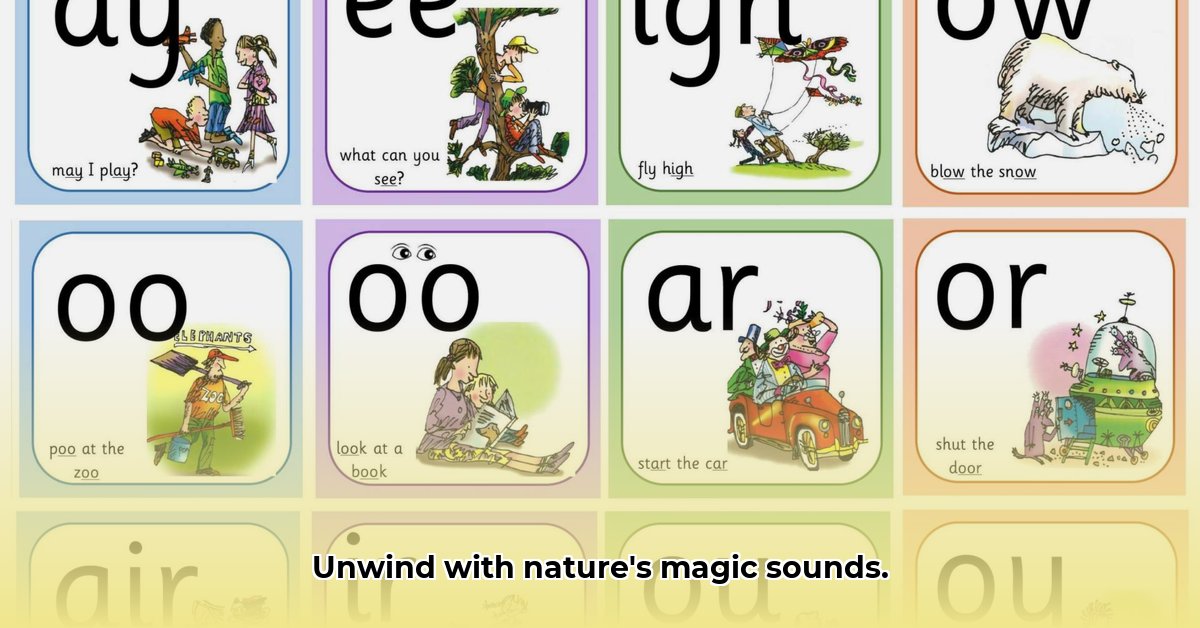Ever been instantly calmed by ocean waves or the gentle rustle of leaves? That’s more than just a feeling; it’s the science of sound impacting your brain and well-being. Learn more about the mind-body connection in this article on the placebo effect. This guide explores how different sounds affect our minds and bodies, revealing the remarkable benefits of nature sounds for relaxation, focus, and overall cognitive enhancement. Discover how to craft your personalized sonic sanctuary for optimal well-being.
Decoding Nature’s Symphony: How Sound Frequencies Influence Brain and Body
Sound isn’t merely background noise; it’s a powerful vibration that directly influences our brain activity and overall well-being. Sound frequencies, measured in Hertz (Hz) – cycles per second, the unit of frequency – can significantly affect our moods, concentration levels, sleep patterns, and cognitive functions. Let’s explore this fascinating world of sonic influence.
The Secret Language of Sound and the Brain: A Primer
Sound travels in the form of energy waves through the air (or other mediums). Frequency, measured in Hertz (Hz), determines the pitch of a sound. A high-pitched sound, like a whistle, has a high frequency, while a low rumble has a low frequency. These frequencies interact with our brains in complex ways.
Brainwaves, the rhythmic electrical activity within our brains, also operate at different frequencies. These frequencies are categorized into distinct bands, each associated with specific mental states and cognitive processes:
- Delta waves (0.5-4 Hz): Deep, dreamless sleep, relaxation, and bodily restoration.
- Theta waves (4-8 Hz): Deep relaxation, meditation, creativity, and memory consolidation.
- Alpha waves (8-13 Hz): Relaxed wakefulness, calm focus, and a state of peaceful awareness.
- Beta waves (13-30 Hz): Alertness, concentration, active thinking, and problem-solving.
- Gamma waves (30-100 Hz): Higher cognitive functions, information processing, learning, and sensory integration.
The phenomenon of “brainwave entrainment” suggests that external sounds can subtly influence our brainwaves, gently guiding them toward a specific state. This opens up possibilities for using sound to enhance various cognitive functions.
The Sonic Impact: How Different Frequencies Shape Our Minds
Different sounds and their corresponding frequencies exert distinct influences on our mental and emotional states:
- Low Frequencies (e.g., 10-100 Hz): Sounds such as ocean waves, gentle rainfall, and low-frequency ambient music can promote relaxation by synchronizing with alpha and theta brainwaves, inducing a sense of calm and tranquility.
- Mid-Range Frequencies (e.g., 200-1000 Hz): Everyday sounds like human voices, birdsong, and musical instruments in this range have complex impacts depending on the context, emotional content, and individual associations.
- High Frequencies (e.g., 2000 Hz and above): Sounds like chirping crickets, rustling leaves, and certain classical music pieces can be stimulating and promote alertness by potentially aligning with beta waves. However, it’s important to note that excessively high-frequency sounds can also be perceived as irritating or stressful.
Nature’s Symphony: A Natural Prescription for Well-being
Nature offers a diverse and intricate soundscape filled with blended frequencies. A forest soundscape, for example, combines the gentle rustling of wind through trees with the melodic songs of birds, creating a rich auditory experience that many people find deeply soothing and restorative. These sounds have been shown to help reduce stress, improve mood, and enhance cognitive function.
While specific frequencies like 432 Hz or 528 Hz are sometimes touted as possessing special healing properties, it’s essential to note that these claims often lack robust scientific evidence. Focus on the overall experience and how it makes you feel.
Binaural Beats: A Technological Twist on Nature’s Harmony
Binaural beats are created by playing slightly different frequencies in each ear, which the brain then interprets as a single, unified tone. This auditory illusion is believed to influence brainwave activity, with some individuals finding them helpful for promoting relaxation, enhancing focus, or inducing sleep. However, further research is needed to fully understand the mechanisms and effectiveness of binaural beats.
Crafting Your Personal Soundscape: A Step-by-Step Guide
Creating your own personalized soundscape is a journey of self-discovery. Here’s a practical guide to help you get started:
- Define Your Goals: Clearly identify what you hope to achieve with your soundscape (e.g., stress reduction, improved concentration, enhanced sleep quality). This will guide your sound selection process.
- Explore Your Sonic Palette: Delve into the vast world of nature sounds (gentle rain, ocean waves, crackling fire, birdsong). Numerous online resources and apps offer a wide variety of options. Experiment with different genres of ambient music and binaural beats.
- Start Slowly and Mindfully: Begin with short 10-15 minute sessions and gradually increase the duration as you become more comfortable. Pay attention to how your body and mind respond to the sounds.
- Listen Intently and Observe: During your soundscape sessions, focus your attention on the sounds and notice any sensations, emotions, or thoughts that arise. This mindful approach will help you deepen your connection to the experience.
- Pay Attention to Your Body’s Signals: If a particular sound feels irritating, unpleasant, or triggers negative emotions, stop immediately and choose a different one. Your body’s feedback is a valuable guide.
- Be Patient and Experiment: Finding the perfect soundscape is an ongoing process of experimentation. Don’t be discouraged if it takes time to discover the sounds that resonate most deeply with you.
A Word of Caution: Responsible Sound Therapy
Sound therapy offers promising potential, but it’s not a panacea. It’s crucial to approach it with a discerning and informed perspective.
- Consult a Healthcare Professional: If you’re considering using sound therapy to address specific medical or psychological conditions, consult with a qualified doctor or therapist first.
- Be Wary of Unsubstantiated Claims: Exercise caution regarding exaggerated or unsubstantiated claims about the healing properties of specific frequencies.
- Start with Low Volumes: When using binaural beats or other sound-based technologies, always start with low volumes to protect your hearing.
- Listen Responsibly: Avoid prolonged exposure to loud sounds, as this can damage your hearing over time.
The Ongoing Symphony: Understanding Sound and Well-being
The connection between sound frequencies and our brains is a complex and multifaceted area of ongoing research. While studies suggest the potential benefits of nature sounds and brainwave entrainment, more rigorous investigation is needed to fully understand the underlying mechanisms and long-term effects. It’s essential to prioritize evidence-based approaches and maintain a healthy dose of skepticism.
Personalizing Sound Therapy Frequencies for Optimal Cognitive Benefits
Can sound therapy frequencies be personalized to maximize cognitive enhancements? Let’s find out.
- Sound therapy, encompassing nature sounds and binaural beats, holds promise for improving cognitive function, elevating mood, and enhancing sleep quality.
- Rigorous scientific validation for the specific effects of individual frequencies remains limited.
- Effectiveness is highly individual, emphasizing the importance of personalized approaches.
- Further research is necessary to elucidate the underlying mechanisms and potential risks associated with sound therapy.
- Combining sound therapy with other evidence-based wellness practices can amplify its benefits.
The Brain-Sound Connection: An Intricate Dance
Brainwaves, including Delta, Theta, Alpha, Beta, and Gamma frequencies, play a critical role in regulating cognitive functions. Sounds can influence these brainwave patterns through brainwave entrainment, a process akin to tuning a radio to a specific frequency.
The Sonic Landscape: Nature’s Frequencies for Well-being
Gentle ocean waves, rustling leaves, and birdsong are just a few examples of nature sounds that can promote relaxation and reduce stress. But how can sound therapy frequencies be tailored to unlock their full cognitive potential? That’s the central question.
Exploring Sound Therapy Modalities: A Toolkit for Cognitive Enhancement
Several sound-based methods can be used to enhance cognitive function:
- Nature Sounds: Experiment with diverse natural soundscapes, such as ocean waves, rainforests, and forest streams, to discover which sounds resonate most effectively with your individual needs and preferences.
- Binaural Beats: These auditory illusions create the perception of a third tone, which may influence brainwave activity and promote specific mental states.
- Isochronic Tones: Pulses of pure tones that may also help entrain brainwaves and enhance cognitive function.
Personalizing Your Sound Therapy: A Roadmap to Cognitive Optimization
- Identify Your Cognitive Goals: Clearly define your objective for using sound therapy. Are you seeking to improve focus, enhance memory, reduce stress, or promote better sleep?
- Experiment with Frequencies and Sounds: Systematically explore different sounds and frequencies, paying close attention to your responses and preferences. Keep detailed notes on your experiences.
- Start Slowly and Mindfully: Begin with short 10-15 minute sessions and listen actively, focusing your attention on the sounds and your body’s responses.
- Maintain a Journal: Document your experiences, including the sounds you used, the duration of the sessions, and any noticeable changes in your cognitive function, mood, or sleep quality.
- Integrate with Other Cognitive Enhancement Techniques: Enhance the effects of sound therapy by combining it with other evidence-based wellness practices, such as meditation, mindfulness exercises, regular physical activity, and a healthy diet.
Potential Benefits & Cautions: A Balanced Perspective
Sound therapy holds the potential to improve sleep quality, reduce stress levels, enhance focus and concentration, and elevate mood. However, it’s crucial to approach sound therapy with a healthy dose of skepticism, as many claims lack robust scientific support.
Some individuals may find certain sounds irritating or unpleasant. Always consult with your healthcare provider before starting any new sound therapy regimen, especially if you have pre-existing medical conditions.
Harnessing Sound Therapy for Improved Sleep Quality and Anxiety Reduction
Can sound therapy be used as a tool to combat anxiety and promote restful sleep?
- Alpha (8-13 Hz) and theta (4-7 Hz) brainwave frequencies have been linked to decreased anxiety and improved sleep quality.
- Nature sounds have demonstrated promise in promoting relaxation and reducing levels of the stress hormone cortisol.
- Effectiveness can vary significantly based on individual factors, such as personality traits, pre-existing conditions, and personal preferences.
Tuning Your Brain: The Calming Power of Nature’s Sounds
Our brains respond to sound frequencies, which in turn influence our moods and stress levels. Different sounds can trigger distinct brainwave patterns, with certain sounds promoting harmony and others creating dissonance.
Frequencies and Brainwaves: A Symphony of the Mind
Sound is measured in Hertz (Hz), with lower frequencies (below 100 Hz) generally considered calming and higher frequencies (above 2000 Hz) often perceived as jarring. Brainwaves also operate at different frequencies depending on our state of consciousness.
Anxiety Reduction: Finding Peace in Sonic Landscapes
Nature sounds, characterized by their richness in low and mid-range frequencies, can be particularly effective for promoting relaxation and reducing anxiety. This is because they often encourage alpha and theta brainwave activity, which is associated with peaceful and meditative states. Relaxation is more easily achieved in natural settings.
Binaural Beats: A Technological Path to Relaxation
Binaural beats involve playing slightly different frequencies in each ear, creating the perception of a third frequency in the brain. By using binaural beats in the alpha or theta range, individuals may be able to promote relaxation and improve sleep quality. It’s crucial to use reputable resources and follow recommended guidelines when experimenting with this method.
Soundscaping for Sleep: Crafting Your Bedtime Ritual
Create a personal soundscape designed to promote better sleep and reduce anxiety:
- Choose Your Sounds Wisely: Select calming nature recordings, gentle ambient music, or binaural beats specifically optimized for relaxation and sleep.
- Adjust the Volume to a Comfortable Level: Keep the volume low and comfortable to avoid any potential irritation or disturbance.
- Establish a Consistent Ritual: Practice listening to your soundscape consistently before bed to create a relaxing and predictable bedtime routine.
- Experiment and Adapt: Find what works best for you and adjust your soundscape as needed to optimize its effectiveness.
Cautions and Considerations: Responsible Sound Therapy
While sound therapy offers significant potential, it’s essential to approach it responsibly:
- Safe Volume Levels: Always use sound at safe volume levels to prevent any risk of hearing damage.
- Consult a Doctor: Individuals with epilepsy or other neurological conditions should consult with their doctors before trying sound therapy.
- Be Mindful of Your Response: Listen to your body and adjust your soundscape accordingly. If any sounds feel uncomfortable or trigger negative emotions, discontinue use immediately.
Harnessing Nature Sounds for Enhanced Focus and Productivity at Work
Optimize your work environment with nature’s symphony to improve your concentration and efficiency. How can you use sound for focus?
- Nature sounds can effectively reduce stress and improve focus in the workplace.
- Different sound frequencies can influence brainwave activity, promoting specific cognitive states.
- Personalization is paramount for achieving optimal results with sound therapy.
- Technology offers convenient access to a wide range of nature sounds and soundscapes.
- Mindful use of nature sounds is crucial for realizing long-term cognitive benefits.
The Symphony of Sound: A Foundation for Focus
Our brains respond to sound frequencies, influencing everything from our mood to our productivity levels. The right sounds act like a perfectly tuned instrument, bringing our minds into a state of harmony and focus.
Frequency and Focus: Shaping Your Brainwaves with Sound
Lower frequencies, such as the gentle murmur of ocean waves, promote relaxation and reduce stress. Higher frequencies, like the chirping of birds, can enhance alertness and concentration. By strategically using sound, we can shape our brain’s state to optimize our cognitive performance.
Tuning Your Environment: Practical Applications for Workplace Productivity
Here’s how to integrate nature sounds into your work environment to boost focus and productivity:
- Identify Your Ideal Soundscape: Experiment with various nature sounds, such as rain, forest streams, or gentle wind, to determine which sounds resonate most effectively with your individual needs and preferences.
- Integrate Sounds into Your Routine: Incorporate nature sounds into your workday as background noise, during breaks, or during specific tasks that require intense focus.
- Practice Mindful Listening: Engage with the sounds intentionally, allowing yourself to become fully present in the moment. This strengthens the beneficial effects of nature sounds on your cognitive function.
- Adapt to the Context: Adjust your soundscape according to the specific task at hand and your current mood. For example, you might choose more stimulating sounds when you need to be alert and focused, and more calming sounds when you need to relax and de-stress.
- Start Small, Build Gradually: Begin with short sessions and gradually increase the duration as you become more comfortable and notice positive effects.
Potential Challenges and Considerations: A Balanced Approach
Mindful use of nature sounds is crucial for maximizing their benefits.
- Sound Quality Matters: Poor quality recordings or artificial sounds can negate much of the positive effects. Invest in high-quality recordings or use reputable sound therapy apps.
- Balance is Key: Integrating nature sounds into a healthy and balanced lifestyle is more effective than relying on them as a sole solution.
Beyond the Sounds: A Holistic Approach to Well-being
Combine the power of nature sounds with other stress-reduction techniques, such as regular exercise, mindful breathing, meditation, and creating a sustainable and supportive physical environment. This holistic approach to well-being will create a synergistic effect, maximizing your cognitive performance and overall quality of life.
- Unveiling Superorganisms: Are Ant Colonies One Mind? - August 2, 2025
- Unveiling The Northern Lights (Aurora Borealis): The Science Behind Nature’s Light Show: 2025 Guide - August 2, 2025
- Unlock Nature’s Sounds: Brain Benefits & Well-being Guide - August 2, 2025













